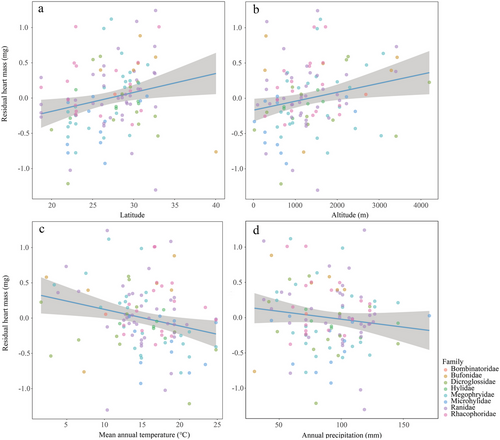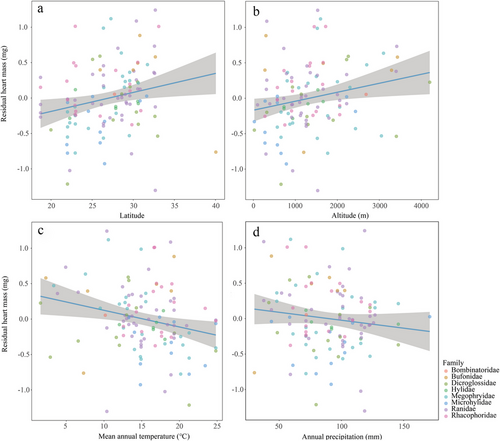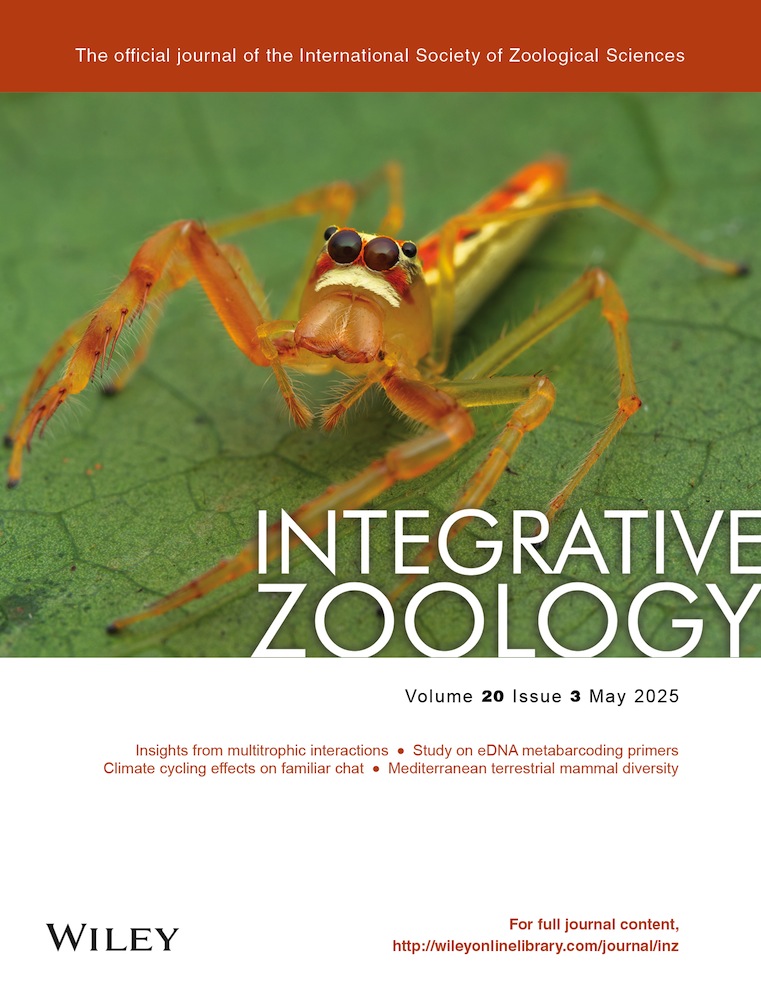Heart size variation in anurans from China does not follow the Hesse's rule
Graphical Abstract
Dear Editor,
Local adaptation in organisms involves changes in morphological, physiological, and biochemical traits in response to diverse environmental conditions (Mai & Liao 2019; Giacomini et al. 2022; Jiang et al. 2023). An organ, an important morphological trait in organisms, undergoes adaptive size adjustments in response to environmental factors (Liao et al. 2022; Zamora-Camacho 2022). Typically, variations in organ size under diverse environments along geographic gradients are affected by factors such as food intake and oxygen fluctuations (Zhong et al. 2017). The heart, a crucial organ in organisms, plays a vital role in assessing survival and fitness (Müller et al. 2014). Significant variations in heart size exist both between and within species, with the Hesse's rule stating that animals adapted to cold environments have a larger heart in relation to body weight than closely related species living in warm habitats (Hesse 1924). Previous studies have confirmed an increase in heart size with increasing altitude across populations of species of rodents and frogs, following the prediction of the Hesse's rule (Müller et al. 2014; Zhong et al. 2017; Cui et al. 2022); however, some studies have yielded inconclusive results (Cardilini et al. 2016; Zhao et al. 2019; Cui et al. 2020; Deng et al. 2023). Although most studies have predominantly concentrated on variations in heart size among populations of a single species, there is no existing evidence to test the Hesse's rule across species distributed in diverse environments. Therefore, investigating variations in heart size across species is crucial in assessing local adaptation for anuran species. We here examined variations in heart size across 116 species of anurans to test the prediction of the Hesse's rule.
We first dissected the correlations between geographical gradients (e.g. latitude and altitude), temperature, rainfall, and wind speed. We did not find any factors likely highly correlated since all |r|< 0.6 (Table S1, Supporting Information). Consequently, we applied phylogenetic generalized least-squares models (PGLS) to test for the effects of latitude, altitude, rainfall, temperature, and wind speed on heart size (relative to body condition) among 116 species of anurans. The PGLS confirmed that latitude and altitude did not affect variations in relative heart size across species (Fig. 1; Table 1). Indeed, previous studies have indicated that animals living at higher geographical gradients are often pressured by lower temperatures, thus evolving larger organs (i.e. heart and livers) to meet normal metabolic demands (Hesse 1924; Müller et al. 2014). For frogs, there is evidence that individuals in high-altitude populations have larger hearts in Polypedates megacephalus due to lower temperature, which aligns with the Hesse's rule (Zhong et al. 2017). However, most studies have failed to identify positive correlations between heart size and geographical gradients (altitude, latitude) in small mammals (Apodemus draco) and frogs (Duttaphrynus melanostictus and Bufo andrewsi) (Cardilini et al. 2016; Zhao et al. 2019; Cui et al. 2020; Zhu et al. 2022; Deng et al. 2023). Interestingly, our initial findings indicated that the relative size of the heart did not increase with rising altitude and latitude across 116 species of anurans, suggesting that variations in geographical gradients may not significantly contribute to relative heart size, contradicting the prediction of Hesse's rule. This is likely to be attributed to the effect of variations in temperature, rainfall, and wind speed among study sites of each species on relative heart size. Hence, it is essential to further investigate the relationships between relative heart size and temperature, rainfall, and wind speed among species.

| Predictor | λ | β | T | R2 | P |
|---|---|---|---|---|---|
| Latitude | 0.456 <0.001, 1 | 1.296 | 1.586 | 0.023 | 0.116 |
| Altitude | 0.070 | 0.473 | 0.002 | 0.637 | |
| Annual precipitation | −0.380 | −1.266 | 0.014 | 0.208 | |
| Mean temperature | −0.042 | −0.125 | <0.001 | 0.901 | |
| Mean wind speed | 0.331 | 0.801 | 0.006 | 0.425 | |
| Body condition | 2.665 | 7.107 | 0.317 | <0.001 |
- Body condition = log10 (body mass) being divided by log10 (SVL).
The PGLS revealed that relative heart size was not affected by annual temperature, rainfall, and wind speed (Fig. 1; Table 1). In a previous study, it was observed that there is a negative relationship between relative heart size and temperature among 14 populations of a toad, suggesting that lower temperature drives the evolution of smaller heart size due to limited energy supply (Zhu et al. 2022). In this study, the non-significant relationship between relative heart size and temperature suggests that scarce energy supply in cold environments does not drive variations in anuran heart size. Indeed, most anuran species involve hibernation when facing further unique challenges for low temperatures, and hibernation avoids scarce energy supply which thus does not affect heart size (Liao et al. 2023). Our findings align with previous studies on the relationships between relative heart size and climatic factors in animals, where rainfall does not promote the evolution of relative heart size (Zhao et al. 2019; Cui et al. 2020; Deng et al. 2023). Wind speed can influence the overall thermal budget of ectotherms, thus affecting variation in relative heart size (Cardilini et al. 2016). However, there was no correlation between wind speed and relative heart size, suggesting that wind speed cannot promote the variations in relative heart size across 116 species of anurans.
In conclusion, our study shows that there is no correlation between the relative size of the heart and altitude, latitude, temperature, rainfall, and wind speed. This suggests that variation in heart size among 116 species of anurans cannot be attributed to the cold environments. We first confirm that variations in heart size in anurans do not follow the Hesse's rule. We infer that the hibernation of anurans resulting from low temperatures avoids limited energy supply, which leads to non-significant variation in relative heart size. In total, we do not find significant effects of climatic and environmental factors on heart size among species. Therefore, it is necessary to take into account the potential influences of global climate change, habitat alteration, and invasion of new habitats among species on variation in relative heart size, as there is support for a universal mechanism of climate-driven size evolution to improve the capacity of local adaptation in animals (Slavenko et al. 2019; Goldenberg et al. 2022). In the future, comprehensive insights into the determinants of heart size variation among anuran species should consider potential factors such as climate change, habitat alterations, and the invasion of new habitats.
ACKNOWLEDGMENTS
This study was funded by the National Natural Science Foundation of China (32300358, 32370456) and the Key Project of the Natural Sciences Foundation of Sichuan Province (22NSFSC0011).





